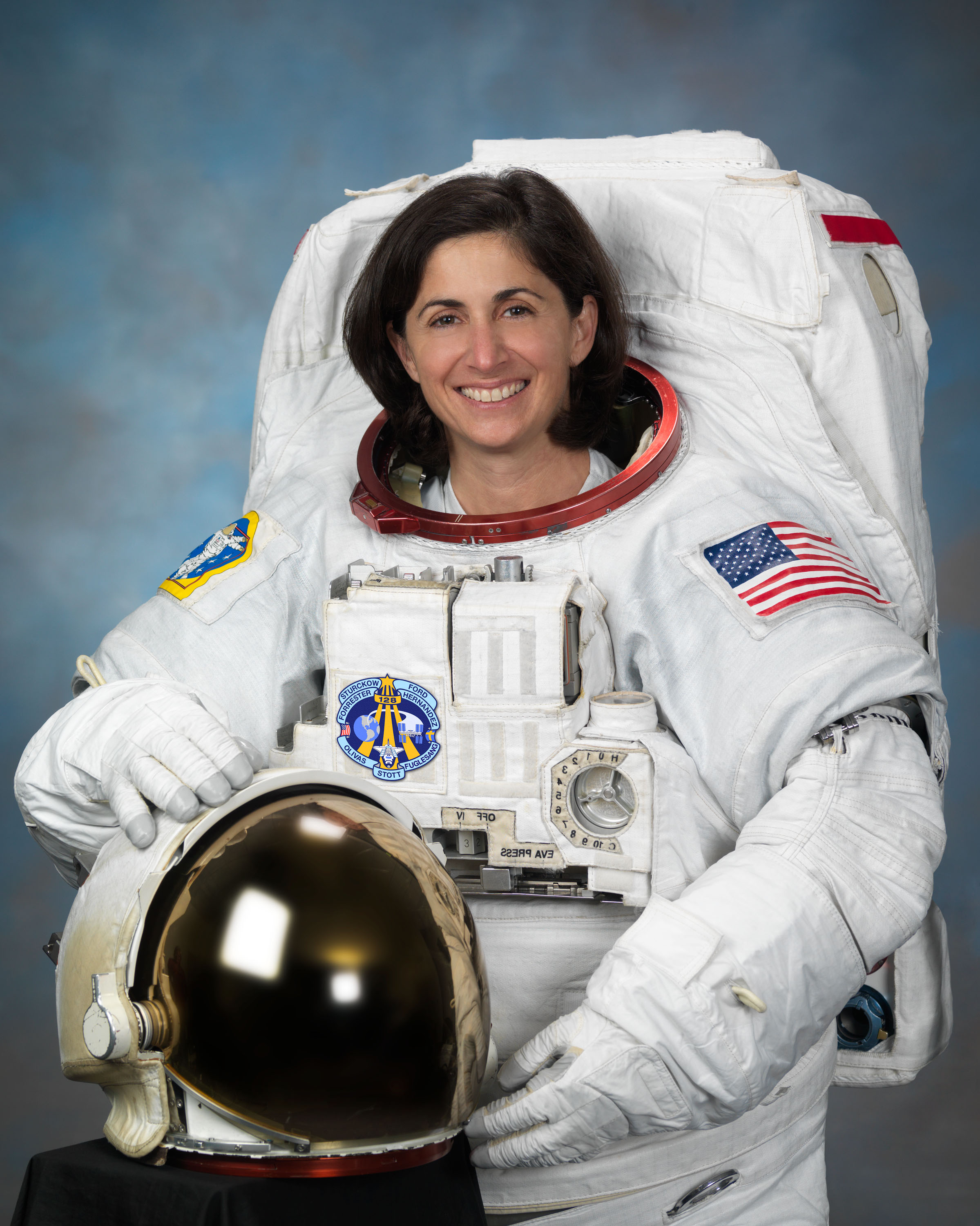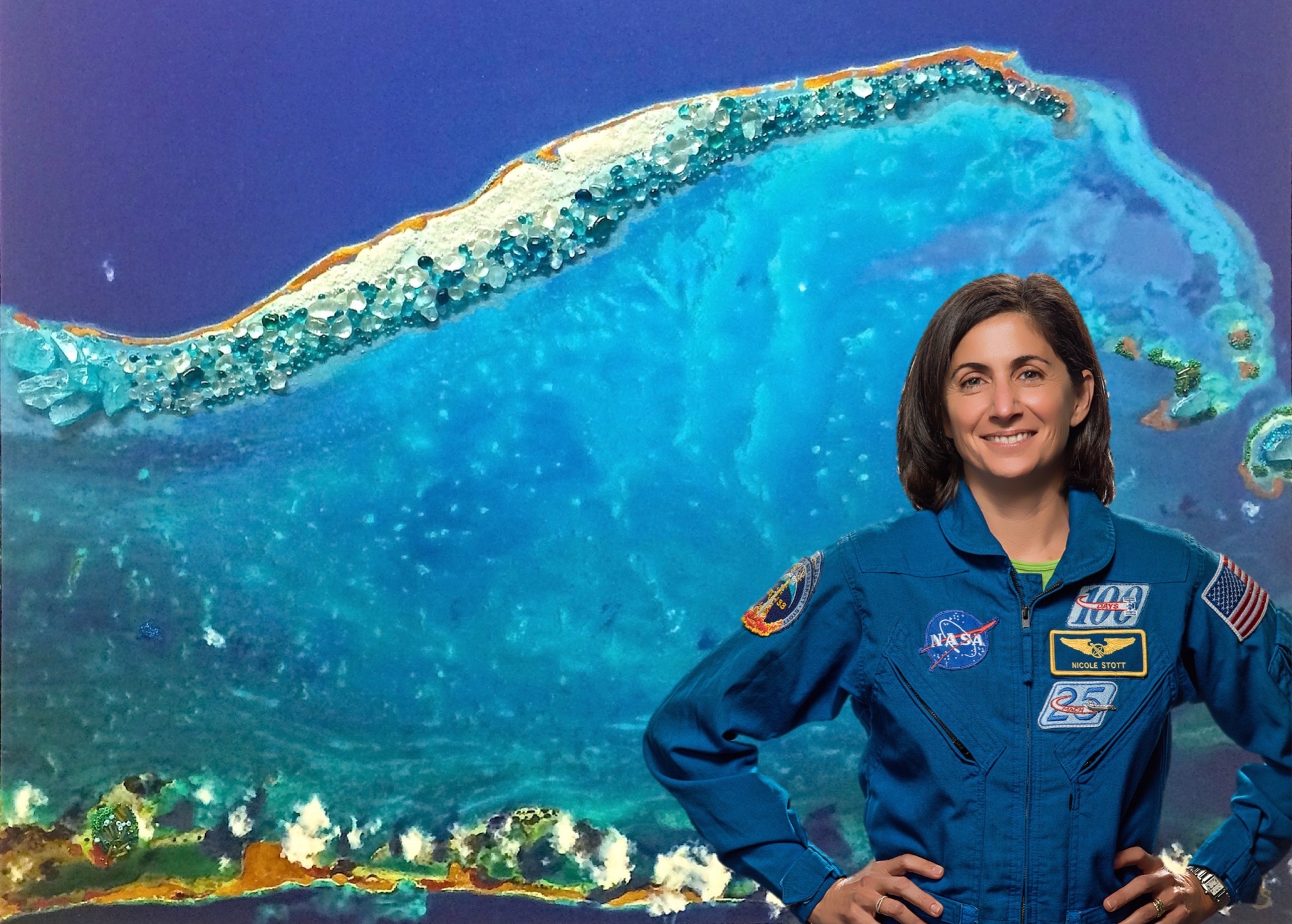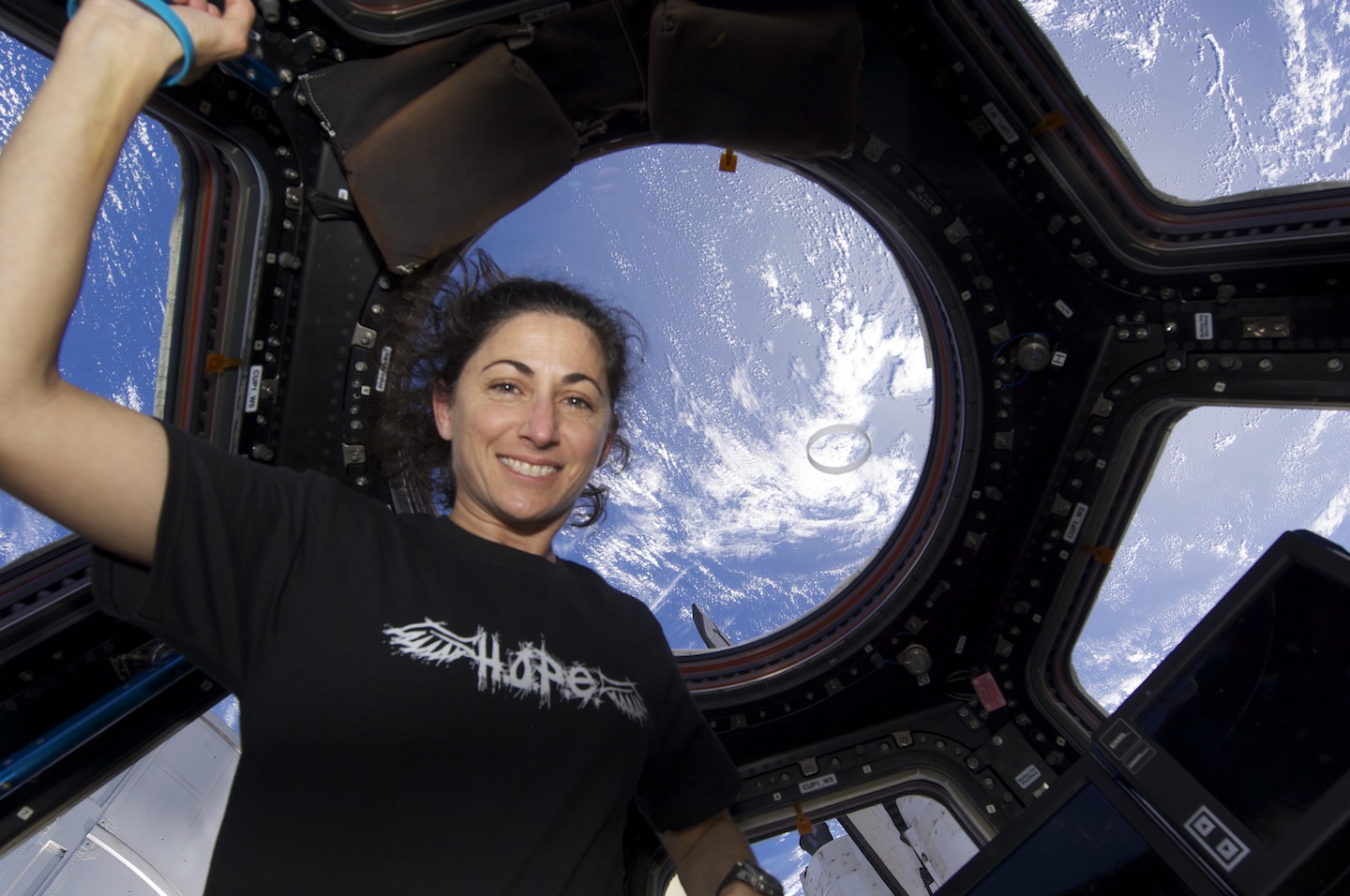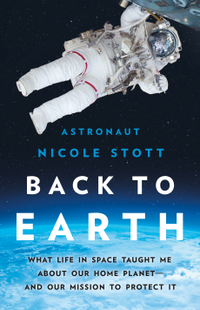In 'Back to Earth,' NASA astronaut brings the space station mindset home
Astronaut-artist Nicole Stott talks life lessons in orbit that could help us all on Earth.

By necessity, traveling to space means leaving Earth — but that round-trip journey also means coming back to Earth, and for retired NASA astronaut Nicole Stott, that piece of the experience was crucial.
Stott outlines how living and working on the International Space Station changed the way she thinks about living on Earth in her new book, "Back to Earth: What Life in Space Taught Me About Our Home Planet — and Our Mission to Protect It" (Seal Press, 2021). (Read an excerpt from "Back to Earth.")
Stott opens "Back to Earth" by telling the story of Apollo 8's famous Earthrise image and encouraging readers to find their own moment of such planetary reflection (without having to travel quite as far as the lunar orbit that mission's crew reached.)
Space.com called Stott to talk about the book, her time in space and what she's been doing since returning to Earth. This interview has been edited for length and clarity.
Related: Best space and sci-fi books for 2021
Back to Earth: What Life in Space Taught Me About Our Home Planet — And Our Mission to Protect It | $25.49 from Amazon
Retired NASA astronaut Nicole Stott outlines how living and working on the International Space Station changed the way she thinks about living on Earth in hopes of inspiring readers to take a new perspective on being an Earthling.
Space.com: Why did you want to write this book?
Nicole Stott: This is not a memoir. Really what I wanted it to be was the story of how we have done such amazing work as this international community on the International Space Station. If I had to sum up the message in the book in the simplest way it would be that I think the greatest skill we could learn as Earthlings is how to be crewmates and not passengers. There's a big, big difference.
Breaking space news, the latest updates on rocket launches, skywatching events and more!
Space.com: It seems notable to me that you waited a while after retiring from the astronaut corps to write this, how did that time affect you?
Stott: I think if I had written this book soon after retiring, it would have been a very different book. It may have been more the memoir, the how did Nicole become an astronaut. A lot of people like hearing those stories, and I enjoy reading the books that my colleagues have written about those experiences, and I think that is compelling in one way.
What I've found interesting, though, is that there's little tidbits in all of those stories that speak in some way or another to what I'm trying to get at in "Back to Earth." And as time went on, I found that for me, wow, those little tidbits were absolutely the more powerful thing.
I hope everyone who reads it finds their own call to action from it, how they can find this path to being crewmembers, and that that can come to life for them through something they read in this book. What thing can they do in their lives that will allow them to take on that role more strongly? What else can they be doing? I don't mean it to be prescriptive in any way. But I want it to be something that they can read and perhaps latch onto in some way that encourages them to find their own path, find their own role.
Space.com: How did you go about the process of combining your memories from space with the Earth-related themes and topics you wanted to cover?
Stott: Each chapter is a call to action on its own based on an experience I had in space, whether that's the training that we do or how we end up working together or the philosophies that we have to create a successful mission.
The first chapter is "act like everything is local." There's this sense of, "What's going on on the other side of the planet?" or, "Oh, that doesn't affect me, because I don't live there." But when you go to space and you look back at Earth, it's like, "Holy moly, we live on a planet." It's one place that, no matter how you look at it, is connected — interconnected — and we are, because of that, interdependent. So anything I do in one place is, in one way or another, whether we realize it or not, affecting every place else and everyone else.

I try to use this experience of seeing Earth from space to bring together the key elements of how we experience that down here on Earth. What I tried to do in each chapter is share some aspect of what it's like to live in space, what brought this way of being to light for me, and how that affected the way we could successfully work as a crew onboard the space station. Then, I showcase work that's happening in space that is in line with that, and then also showcase someone who is already working in not just a very passionate way but in a very successful way to bring that way of being to life, doing things here on Earth that are improving life for all of us.
Space.com: Your astronaut class is nicknamed the "Bugs" and you have this lovely sad story of watching damselflies as a kid and then realizing you hadn't seen them in years and years. When did you make the connection between those two snippets of your life?
Stott: It was while I was writing the book, I was starting to think about experiences I've had. Part of what I share in that chapter is there's been a lot in the news with respect to extinction-level events — like the "insect apocalypse" — and you read a headline like that, and you're like, "What the heck?"
I tried to figure out "how can I relate what I'm reading about something that's happening on a planetary scale to something I've experienced in my own life?" And I realized that wow, I can't remember the last time I saw one of these little beautiful bugs that I had been surrounded by as a kid. Thankfully, thanks to some of the people I spoke to, I discovered that they have not disappeared, they are still with us, while not in mass like they were and how I remember as a child. I just remember crying and being so thankful that they weren't gone.

Since then, I keep my eye out for them and I, very fortunately, have come across them again. The other day, there was this one lone blue damselfly at the glass, and I took a picture of it, because it just shocked me. It was like this little gift from God or something to remind me that it's important for us to pay attention to these creatures and the role they have with us, but also that they haven't left us yet. It just reminded me — and this is something I tried to share in the book too — that we just have to be open and looking for the awe and wonder around us all the time.
And that little damselfly comes back — I don't know if it's the same one or not. But I think there's things like that in all of our lives, right? Where we've just somehow moved along in our life and we forget about things, and then they come back for whatever reason to remind us of something special or to help make us aware of other things that are going on around us and to help us open our heart — not just our eyes, but our hearts and our minds — to what these things are sharing with us.
Space.com: You write favorably about watching spaceflyer Guy Laliberté’s space station visit in 2009. I’m curious what your thoughts are on private spaceflight now with the Inspiration4 mission back from orbit and Axiom’s first flight bound for the space station scheduled to launch next year?
Stott: I'm so excited about all of this. I think it's raising awareness in people. Some people are not so pleased with it. Others, like me, I'm really, really excited about it. And I'm really hopeful that the people that aren't pleased or don't understand the goodness in this, that maybe they haven't been privy to or haven't been excited about space exploration in general. If you pay attention to what's going on in the space industry, really all that's happening in space is ultimately about improving life on Earth. I honestly believe that.
Guy coming to the station — somebody could look at that like, "Oh, here's this billionaire who got to fly to space, spent 10 days, 12 days on the space station, checked that off his bucket list, and then moved on." What I saw in Guy and [other private visitors to the space station], every single one of them, for sure, had their personal motivation of wanting to fly in space one day, to experience that on every level that you can, and then fortunately had the opportunity to do that. But I also can say that for every single one of them, in one way or another, that mission was a mission. It was bigger than just them and their desire to fly in space. Guy was a perfect example of that: He used that whole flight in a way to extend on his mission on Earth to make people more aware of access to clean water.

I think that in one way or another, that is happening with all of the people that are going to find their way to space. It's certainly true for astronauts that are part of NASA or the government programs. I don't think we all do it because it's this adventure. There certainly is the adventurous part of it — I'm going to float, I'm going to fly, I'm going to ride a rocket — but I would not have done any of that if I didn't believe that the work was worthwhile and that I was going to be part of something that was bringing back something good to Earth. I certainly wouldn't strap myself to a rocket with my seven-year-old at home watching me do that if I didn't believe that what I was going to do was going to have some positive impact on his life, on his future.
Space.com: Is there anything else you'd like to highlight about the book?
Stott: The call to action thing is a big deal to me. I really want people to read this and certainly be inspired by what we're doing in space to learn more about that and how these things are improving life on Earth. But [also] I want them to find their own personal call to action as Earthlings, as crewmates.
I can't oversimplify it any more than I do with what I learned from all the complexity of space, which is:
Oh my gosh, we live on a planet.
We are all Earthlings.
The only border that matters is that thin blue line of atmosphere.
Those are absolutely the three things that interconnect all of us on our mission as crewmates here on Spaceship Earth.
I will admit, I did not myself actively think of all of those things, those simple things in my daily life before flying to space. And I want people to grasp them, to bring them into their own lives and realize that you don't have to fly to space to understand these things. And it really, really should inspire us to want to live like a crew, to respect and take care of each other and all life we share the planet with — and the planet itself.
You can buy "Back to Earth" at Amazon or Bookshop.org.
Email Meghan Bartels at mbartels@space.com or follow her on Twitter @meghanbartels. Follow us on Twitter @Spacedotcom and on Facebook.
Join our Space Forums to keep talking space on the latest missions, night sky and more! And if you have a news tip, correction or comment, let us know at: community@space.com.

Meghan is a senior writer at Space.com and has more than five years' experience as a science journalist based in New York City. She joined Space.com in July 2018, with previous writing published in outlets including Newsweek and Audubon. Meghan earned an MA in science journalism from New York University and a BA in classics from Georgetown University, and in her free time she enjoys reading and visiting museums. Follow her on Twitter at @meghanbartels.

